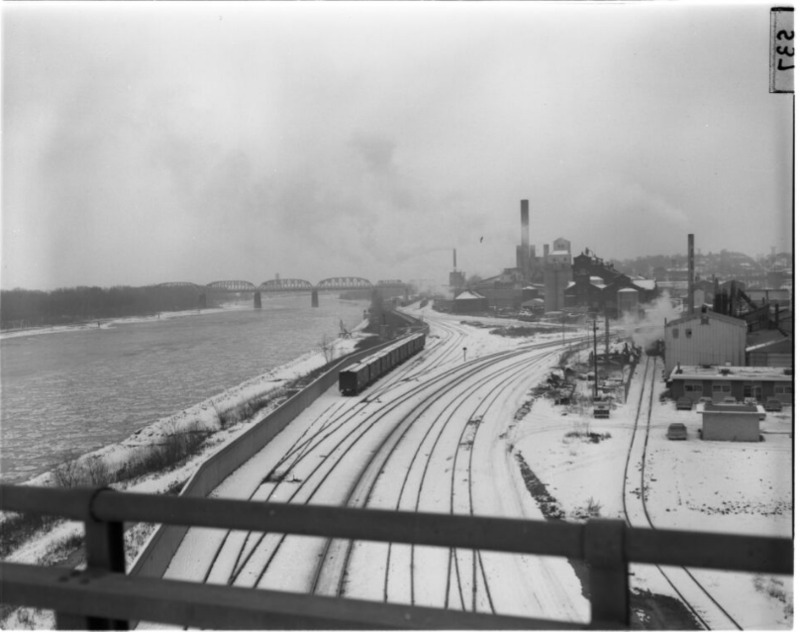ASARCO
ASARCO was both Omaha’s longest running and heaviest polluter in regards to industrial lead, and bears the most responsibility for exposing the public to soil lead contaminants of all studied remediation sites. ASARCO began operations in 1889 as a factory in which lead was smelted and produced. By 1914 ASARCO was commonly referred to as the largest lead refinery in the world, and the pivotal piece in developing Omaha’s rapid economic boom and social development (Sasse, 05). ASARCO was located directly on the Missouri River at the edge of what is now Lewis and Clark Landing.
ASARCO was an economic dynamo for powering nearly every subsequent industry that found success in Omaha. Lead produced at ASARCO was initially sold to support other industries in and around Omaha in their endeavors to produce inexpensive goods (Fletcher, 2019). ASARCO saw particularly beneficial partnerships with both Union Pacific Railways and General Motors, providing both companies with stronger, more durable, and less expensive raw materials to build with (Fletcher, 2019). Lead smelted at ASARCO was exported not only throughout Omaha, but across the Midwest and the United States. ASARCO routinely went through periods of expansion and restructuring projects to accommodate for continuous rapid growth (Fletcher, 2019).
As the largest lead refinery in the world ASARCO developed an unsustainable practice to deal with the biproducts of its industry: Polluting the areas surrounding the factory indiscriminately. This practice of widespread and irresponsible polluting by lead smelters is not unique to Omaha nor ASARCO. This pollution left the smeltery through the construction of smokestacks, channeling toxic biproducts out of the factory and into the atmosphere. These smokestacks were an iconic feature of ASARCO that is visible in every photo record available to our team. The smokestacks released a thick plume of smoke, indicative of ASARCO’s unrelenting pursuit of industrial lead.
ASARCO polluted heavily during its entire tenure of operation, raining the biproducts of industrial lead down upon unsuspecting citizens (Fletcher, 2019). Pollution from the facility began to decrease in the 1970s as growing pressure from the EPA and the public in Omaha grabbed corporate attention. There was a great deal of civic attention drawn to airborne pollution from the extensive exposure ASARCO employees received at the plant. A legal battle in 1974 caused the company to face three officials representing the Secretary of Labor for a visit to the plant to investigate claims of hazardous levels of airborne lead (LOC, 1974). Fearing the fiscal repercussions of being investigated by the Federal government, ASARCO begrudgingly complied with EPA requests while simultaneously promoting disinformation surrounding industrial lead. ASARCO frequently amplified critiques of the EPA’s integrity and intentions made by community members such as Harold Andersen from the Omaha World Herald. These opinion pieces frequently gave voice to corporate interests, letting ASARCO representatives shift blame onto lead paint and away from their refinery (Anderson, 1969). ASARCO attempted to deflect responsibility by shifting blame to the role white lead played as a source of exposure to lead contaminants (EPA, 1972).
Ultimately the efforts ASARCO took to subvert regulation from the Federal government were in vain; the EPA concluded ASARCO was primarily responsible for lead-based pollutants in 1972, with ASARCO confirming such conclusions after massive public pressure campaigns until 1995. (Fletcher, 2019) In 1996, ASARCO was ordered by the EPA to pay a fine of $3.6 million for their role in exposing the public to biproducts of industrial lead by the EPA. The site began the process of closing 1997, and a letter sent from the Omaha City Council in 1998 asking for EPA intervention resulted in ASARCO receiving a unilateral order for compliance in 1999 (EPA, 1999).
Between 1999 and 2003 the EPA studied the impact of ASARCO and concluded that it was the most prominent and prolific polluter of Omaha through industrial lead. ASARCO serves as a testament to the theme of ‘The House of Butterflies’ that once pollutants are linked to certain industries workers and civilians will demand more action from responsible parties. Markowitz and Rosen highlight that once issues are internalized within a community action can be swift and organized. The community of Omaha ‘woke up’ to the situation around them, and demanded previous wrongs to be atoned for. ASARCO’s final saga in Omaha was one of corporate negligence, unfulfilled promises, and massive legal fees and fiscal penalties to assist in future remediation efforts.
